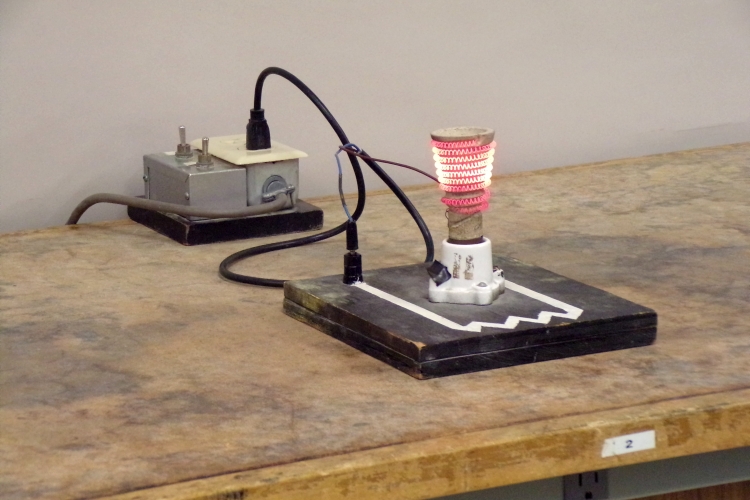
A nichrome wire glows red when connected to 120 VAC, showing the heat produced when current flows through an element that has electrical resistance.
As demonstration 64.09 -- Ohm’s law illustrates, when you place a potential difference across a resistor (by, for example, connecting its ends to opposite poles of a battery or power supply), a current flows through the resistor, whose magnitude is linearly proportional to the potential difference and inversely proportional to the resistance of the resistor. That is, V = iR, where V is the potential difference in volts, i is the current in amperes, and R is the resistance in ohms. Resistance, so called because a resistor resists the flow of current being forced through it, arises from the interaction of the conduction electrons in the resistive element, in this case a nichrome wire, with the atomic lattice that makes up the element. (See demonstration 64.15 -- Resistance simulator.) This is analogous to friction, and it causes energy to be dissipated in the resistor as heat. In this demonstration, the resistive element is a nichrome (a nickel-chromium alloy) wire, whose resistance when cold is about 15 Ω.
The power required to establish a flow of current is the product of the current and the voltage that is pushing the current through the circuit, or P = iV. (A volt is a N-m/C, or J/C, and an ampere is a C/s, so iV is in units of J/s, or watts.) We can see by Ohm’s law that the current through a resistor, i, equals V/R, and that since V = iR, the power dissipated in the resistor, iV, also equals i2R. When you apply power to the heat coil, it draws about 6.1 A. Its resistance when hot, then, is V/i = 120/6.1 = 20 Ω. The power dissipated in the heat coil, iV or i2R, is thus about 730 W (6.1 × 120, or 6.12 × 20).
This is exactly how such appliances as toasters and electric ranges work. In a toaster, the heating elements are nichrome wires wound around flat panels, usually mica, next to which the slices of bread rest when they are being toasted. In electric ranges and toaster ovens, the resistive elements are encased in a ceramic material, which in turn is protected by an outer sheath, either metal or glass. Percolators, drip coffee makers and electric kettles also use resistive heating elements, again, usually encased in ceramic, with an outer metal sheath.